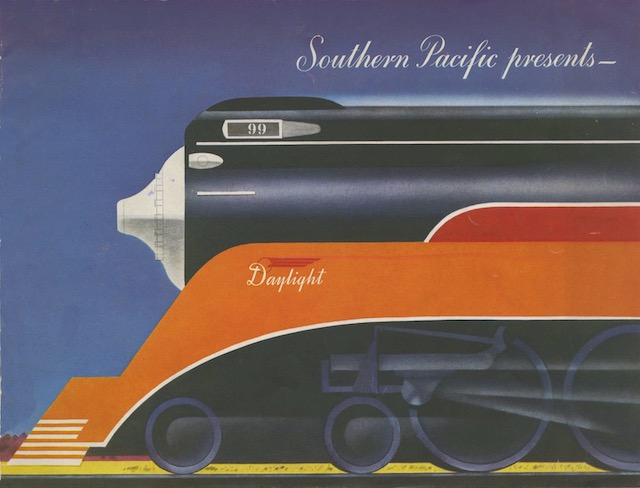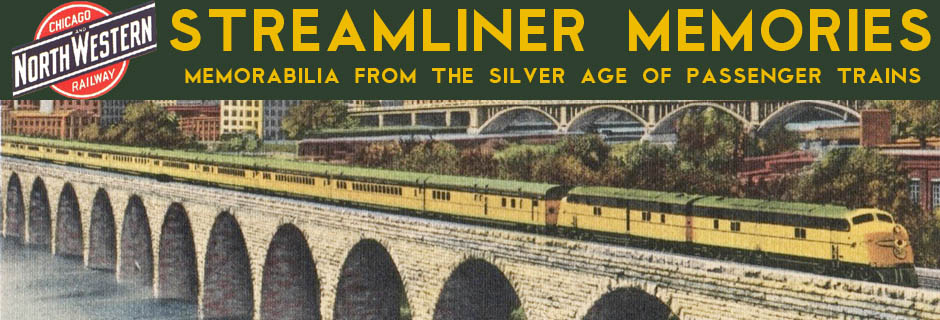We’ve previously seen a name-train booklet for the first Daylight train. This one is much fancier, with full color illustrations of train interiors and exteriors. It wasn’t unusual for railroads to produce two booklets to introduce new trains, one for VIPs and one for ordinary people; compare, for example, this full-color booklet with this one-color booklet for the 1947 streamlined Empire Builder.
 Click image to download a 4.7-MB PDF of this 16-page booklet.
Click image to download a 4.7-MB PDF of this 16-page booklet.
Neither of the Daylight booklets are dated, but as the train was introduced in 1937 and the illustration’s in today’s booklet are all paintings, not photos, it is likely from 1937 while the other one, which has black-and-white interior photos, might be from that year or a year or so later. Railroads often relied on illustrations from the manufacturer to advertise a train before the train itself was delivered but often used photos after they were avaiable.
The bright interior colors certainly must have looked exciting to people used to the dark interiors of heavyweight trains. Today, the pastels seem boring, especially when contrasted to some of the even brighter colors used in the postwar Sunset Limited.
Both booklets have a centerfold illustration of the Daylight cruising by what looks like Mission Santa Barbara, though SP tracks in fact weren’t that close to the mission. The picture in this book is in color while the one in the other booklet is in black-and-white. Buffy the Vampire Slayer fans may remember a framed version of this picture gracing one of the walls of Buffy’s house.
Today’s booklet has color illustrations and floor plans of a typical chair car, tavern car, dining car, coffee shop, and observation car. These are replaced by black-and-white photos in the other booklet. Photos may be more honest, but being black-and-white does no justice to the train Southern Pacific was proud to call the most beautiful in the world. This booklet also has eleven black-and-white photos of some of the scenes visible along the route of the train, four of which also appeared in the other booklet.
The locomotive pictured in these booklets was the first of Southern Pacific’s GS-2, the GS meaning Golden State or General Service depending on when SP ordered them. (General Service during the war as the War Production Board wouldn’t allow construction of new locomotives for passenger service.) The GS-2s were slightly smaller and less powerful than the GS-4 4449 that is currently owned by the city of Portland. The latter locomotive has 80″ driving wheels compared with 73-1/2″ on the GS-2 and its boiler was rated up to 300 pound per square inch, vs. 250 on the GS-2. But both were painting, at least briefly, in the same bright Daylight colors and were probably indistinguishable to most passengers.

The Coast Daylight has the distinction of being the only train SP did not at one time or another attempt to discontinue. SP would keep trains going as long as they covered their direct (or “above the rails”) costs of operation, so one assumes the Daylight performed well enough for long enough that not even Don Russell would axe 98 & 99.